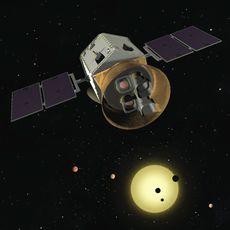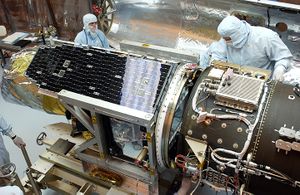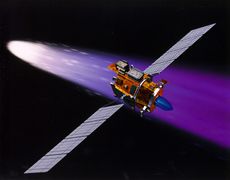اوربيتال ساينسز
 | |
| النوع | حكومية |
|---|---|
| رمز التداول | NYSE: ORB |
| الصناعة | الطيران الفضائي والدفاع |
| تأسست | ڤيينا، ڤرجينيا، الولايات المتحدة (1982) |
| المؤسس | ديڤد و. ثومپسون بروس و. فرگسون سكوت ل. وبستر |
| انحلت | 9 فبراير 2015 |
| المقر الرئيسي | ، |
| نطاق الخدمة | عالمية |
الأشخاص الرئيسيون | ديڤد و. ثومپسون، الرئيس والرئيس التنفيذي گاريت ف پيرس، نائب الرئيس والمدير المالي أنطونيو ل. إلياس، نائب الرئيس التنفيذي والمدير التقني |
| المنتجات | مركبات الاطلاق الفضائية، نظم الدفاع الصاروخي والنظم المرتبطة، النظم الفضائية المتقدمة، الخدمات التقنية الفضائية |
| الدخل | ▲ 1.37 بليون دولار أمريكي (FY 2013)[1] |
| ربح العمليات | ▲ 113.55 مليون دولار أمريكي (2013)[1] |
| ▲ 68.37 مليون دولار أمريكي (2013)[1] | |
| إجمالي الأصول | ▲ |
| إجمالي الأنصبة | ▲ 795.3 مليون دولار أمريكي (2013)[1] |
| الموظفون | 3.300 +(فبراير 2014)[1] |
| الأقسام | مجموعة نظم الاطلاق نظمة النظم الفضائية مجموعة البرامج المتقدمة قسم الخدمات التقنية |
| الموقع الإلكتروني | www.orbital.com |
اوربيتال ساينسز Orbital Sciences Corporation (يشار اليها اختصاراً اوربيتال)، هي شركة مقرها الولايات المتحدة متخصصة في تصميم، تصنيع واطلاق النظم الصاروخية والفضائية الصغيرة والمتوسطة لأغراض حكومية تجارية، عسكرية، ومدنية. المقر الرئيسي للشركة مدينة دولس، ڤرجينيا، وهي مدرجة في بورصة نيويورك برمز ORB. المنتجات الرئيسية لاوربيتال هي السواتل ومركبات الاطلاق، تشمل المدار المنخفض للأرض، والمدار المتزامن جغرافياً ومركبات الفضاء الكوكبية المخصصة للاتصالات، الاستشعار عن بعد، المهمات العلمية والدفاعية؛ النظم الفضائية المأهولة لمدار الأرض، المهمات القمرية والفضائية الأخرى؛ صواريخ توصيل السواتل للمدارات؛ ونظم الدفاع الصاروخي المستخدمة كاعتراضية ومركبات الهدف. توفر اوربيتال أيضاً نظم فرعية ساتلية وخدمات تقنية مرتبطة بالفضاء للوكالات والمعامل الحكومية.[2]
في 29 أبريل 2014، أعلنت اوربيتال ساينسز عن دمجها مع أليانت للنظم التقنية لتأسيس شركة جديدة تسمى اوربيتال إيه تي كيه.[3] المقر الرئيسي لاوربيتال إيه تي كيه في المقر الحالي لاوربيتال في دولس، ڤرجينيا.[3]
في 28 أكتوبر 2014، الصاروخ أنتارس الذي بنته اوربيتال، والمخصص لإمدادات محطة الفضاء الدولية، انفجر بعد ثواني من إقلاعه. فقدت حوالي 2.250 كگ من المعدات وعدد من التجارب العلمية. ولم يسفر الانفجار عن وقوع إصابات.
التاريخ
أقسام الشركة
مجموعة النظم الفضائية
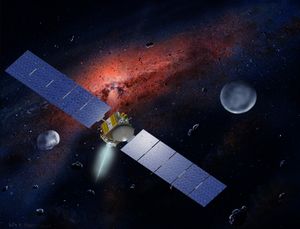
مجموعة نظم الاطلاق
مجموعة البرامج المتقدمة

قسم الخدمات التقنية
مواقع المرافق الرئيسية
المواقع الرئيسي لمرافق اوربيتال-[4]
- دولس، ڤرجينيا- المقر الرئيسي للشركة والموقع الرئيسي لتصميم وتصنيع السواتل
- منشأة والوپس للطيران، ڤرجينيا- تجميع مركبات الاطلاق، الاختبار والاطلاق؛ معالجة مركبات لوجستيات الشحن؛ تجميع لصواريخ الأبحاث؛ الاختبار، الاطلاق والاطلاق
- تشالندر، أريزونا - تصميم مركبات وتصنيع مركبات الاطلاق ومكاتب البرامج
- گلبرت، أريزونا- تصميم وتصنيع السواتل
- گرينبلت، مريلاند- قسم الخدمات التقنية
- Vandenberg Air Force Base, California- تجميع مركبات الاطلاق، الاختبار والاطلاق
- هنتيگتون بيتش، كاليفورنيا- المركز الهندسي بجنوب كاليفورنيا
- هنتسڤيل، ألاباما- هندسة وتصنيع نظم الدفاع الصاروخي
منتجات اوربيتال
مركبات الاطلاق الصاروخي
- Minotaur- Employing a combination of U.S. government-supplied rocket motors and Orbital's commercial launch technologies, the Minotaur family of launchers provides low-cost and reliable access to space for government sponsored payloads.[5]
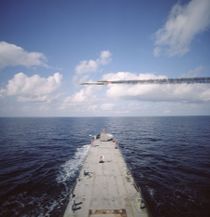 The GQM-163A Coyote flies over the bow of the U.S. Navy observation ship during a routine test
The GQM-163A Coyote flies over the bow of the U.S. Navy observation ship during a routine test- Minotaur I- Minotaur I made its inaugural flight in January 2000, successfully delivering several small military and university satellites into orbit and marking the first-ever use of residual U.S. Government Minuteman boosters in a space launch vehicle. To date, Minotaur I has conducted 11 missions with a 100% success record, having launched a total of 62 satellites.
- Minotaur IV-The Minotaur IV space launch vehicle consists of three Peacekeeper solid rocket stages, a commercial Orion 38 fourth-stage motor and subsystems derived from OSC's established space launch boosters, including a flight-proven standard 92-inch fairing. Capable of boosting payloads more than 1,750 kg into orbit, Minotaur IV supports dedicated or shared launch missions and is compatible with multiple U.S. government and commercial launch sites. The inaugural Minotaur IV flight occurred in 2010 and five missions have been conducted to date with a 100% success record boosting nine satellite into orbit and two hypersonic flight vehicles on suborbital trajectories.
- Minotaur V-Minotaur V is a five-stage evolutionary version of Minotaur IV to provide a cost effective capability to launch U.S. Government-sponsored small spacecraft into high energy trajectories, including Geosynchronous Transfer Orbits (GTO) as well as translunar and beyond. Like Minotaur IV, the first three stages of the Minotaur V are former Peacekeeper solid rocket motors. The fourth and fifth stages are commercial STAR™ motors. The inaugural Minotaur V mission successfully boosted NASA's LADEE spacecraft on a lunar trajectory in September 2013.
- Minotaur VI - The Minotaur VI vehicle adds a lower stage to the existing and flight demonstrated Minotaur IV vehicle configuration providing a significant increase in performance with only a modest increase in cost. Capable of boosting up to 2,600 kg to Low-Earth Orbit, Minotaur VI is also available with an optional upper-stage motor for high energy trajectory missions.
- Minotaur-C - The Minotaur-C (formerly known as Taurus) space launch vehicle is a commercial variant of the Minotaur product line designed to serve the U.S. government market.
- Pegasus- The three-stage Pegasus is used to deploy small satellites weighing up to 1,000 pounds into low-Earth orbit. Pegasus is carried aloft by the "Stargazer" L-1011 aircraft to approximately 40,000 feet over open ocean, where it is released and free-falls five seconds before igniting its first-stage rocket motor. With its unique delta-shaped wing, Pegasus typically delivers satellites into orbit in a little over 10 minutes. Since its debut in 1990, Pegasus has conducted 42 missions, launching 86 satellites.
- Antares - Antares is a two-stage launch vehicle designed to deliver medium-class payloads weighing up to 6120 kg into space. Antares utilizes refurbished Russian-built engines which were originally manufactured in the 1960's[6]. Initially developed to demonstrate commercial re-supply of the International Space Station under a NASA contract, the Antares provided access to a variety of orbits for civil, commercial and military payloads. The first launch of Antares took place from NASA's Wallops Flight Facility on April 21, 2013. The Antares suffered a failed launch on October 28, 2014, that completely destroyed the vehicle and badly damaged the launch pad at Wallops Island, Virginia.[7]
خدمات اعادة الامداد التجارية
نظم الدفاع الصاروخي
سواتل الاتصالات
|
|
|
|
سواتل التصوير
- GeoEye-1
- OrbView-4
- OrbView-2
- OrbView-1
- Earlybird-1
السواتل العلمية والبيئية
Orbital built Science and Environmental satellites conduct astrophysics, Remote sensing/Earth Observation, heliophysics, planetary exploration and technology demonstration missions. These satellites are built on Orbital's LEOStar-1,-2, or -3 satellite platforms depending on the mission requirements and budget.[8]
Astrophysics satellites
Orbital's current and heritage astrophysics satellites are as listed below:
- Transiting Exoplanet Survey Satellite (TESS) for NASA/ MIT- launch expected in 2017
- Nuclear Spectroscopic Telescope Array (NuSTAR) for NASA/ JPL- launched in 2012
- Fermi Gamma-ray Space Telescope for NASA GSFC- launched in 2008
- Swift Gamma-Ray Burst Mission for NASA GSFC- launched in 2004
- Galaxy Evolution Explorer (GALEX) for NASA GSFC- launched in 2003
- Far Ultraviolet Spectroscopic Explorer (FUSE) for NASA/ Johns Hopkins University- launched in 1999
- Extreme Ultraviolet Explorer (EUVE) for NASA- launched in 1992
Remote sensing/Earth observation
Orbital's current and heritage Remote Sensing/Earth Observation satellites are as listed below:
- Ionospheric Connection Explorer (ICON) for NASA GSFC- launch expected in 2016
- Ice, Cloud, and Land Elevation Satellite-2 (ICESat-2) for NASA GSFC- launch expected in 2016
- Orbiting Carbon Observatory-2 (OCO-2) for NASA/JPL- launched in 2014
- Landsat 8 for NASA/USGS- launched in 2013
- Glory for NASA GSFC- launched in 2011 (did not achieve orbit due to a launch failure)
- Orbiting Carbon Observatory (OCO) for NASA/JPL- launched in 2009 (did not achieve orbit due to a launch failure)
- Aeronomy of Ice in the Mesosphere (AIM) for NASA/Hampton University- launched in 2007
- FORMOSAT-3/COSMIC for National Space Organization Taiwan- launched in 2006
- Coriolis for Naval Research Laboratory and Air Force Research Laboratory- launched in 2003
- QuikTOMS for NASA GSFC- launched in 2001 (did not achieve orbit due to a launch failure)
- SeaStar for NASA/ORBIMAGE- launched in 1997
- MicroLab-1 for NASA/UCAR- launched in 1995
- TOPEX/Poseidon for NASA/CNES (France)- launched in 1992
- Upper Atmosphere Research Satellite (UARS) for NASA- launched in 1991
- Landsat 5 for NASA/USGS- launched in 1984 (the satellite holds Guinness World Record for longest operating earth observing satellite)
- Landsat 4 for NASA/USGS- launched in 1982
Heliophysics
Orbital's heritage Heliophysics satellites are as listed below:
- Interstellar Boundary Explorer (IBEX) for NASA/SwRI- launched in 2008
- Solar Radiation and Climate Experiment (SORCE)]] for NASA/LASP- launched in 2003
- Reuven Ramaty High Energy Solar Spectroscopic Imager (RHESSI) for NASA/ University of California, Berkeley- launched in 2002
- Active Cavity Radiometer Irradiance Monitor Satellite (ACRIMSAT) for NASA/ JPL- launched in 1999
Planetary exploration
Orbital's heritage Planetary Exploration Heliophysics satellites are as listed below:
- Dawn for NASA/ JPL- launched in 2007
- Deep Space 1 for NASA/ JPL- launched in 1998
نظم الأمن القومي
نظم الطيران المتقدم
انظر أيضاً
المصادر
- ^ أ ب ت ث ج "Orbital Sciences Corporation 2013 Annual Report"
- ^ "About Orbital Sciences Corporation". June 2014.
- ^ أ ب "Orbital-ATK merger News Release". Orbital. June 2014.
- ^ "Orbital Locations". Orbital. June 2014.
- ^ "Minotaur". Orbital.com. June 2014.
- ^ http://www.theguardian.com/science/2014/oct/28/antares-rocket-explodes-nasa-launch-pad-orbital-science
- ^ http://spaceflightnow.com/2014/10/26/live-coverage-antares-rocket-set-for-launch-monday-from-virginia/
- ^ "Orbital Science and Imaging Satellites". Orbital. June 2014.
